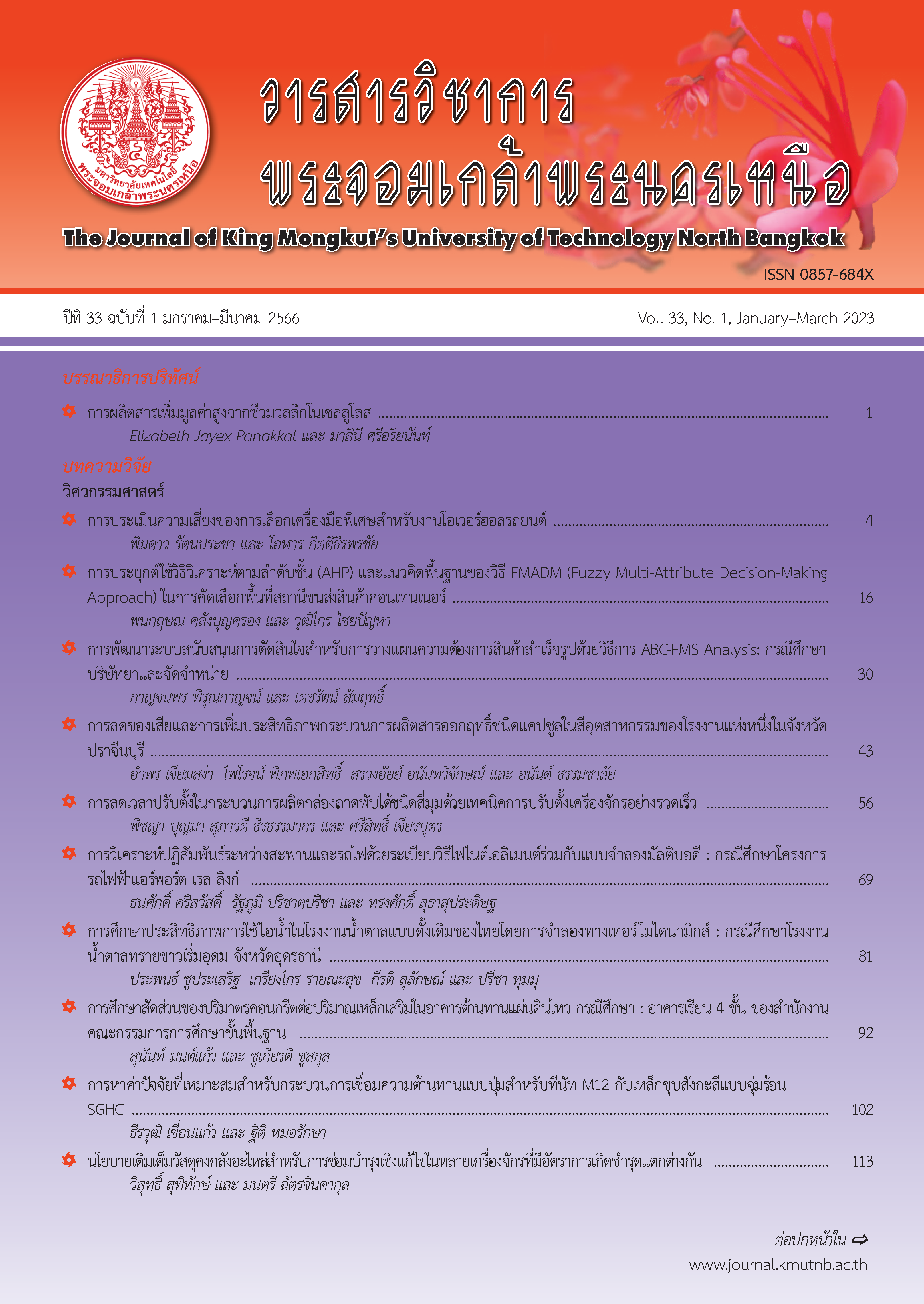การวิเคราะห์ปฏิสัมพันธ์ระหว่างสะพานและรถไฟด้วยระเบียบวิธีไฟไนต์อิลิเมนต์ร่วมกับแบบจำลองมัลติบอดี้ : กรณีศึกษาโครงการรถไฟฟ้าแอร์พอร์ต เรล ลิงค์
Main Article Content
บทคัดย่อ
งานวิจัยนี้มีวัตถุประสงค์เพื่อวิเคราะห์ผลตอบสนองแบบปฏิสัมพันธ์ระหว่างรถไฟและสะพานด้วยระเบียบวิธีไฟไนต์อิลิเมนต์ (Finite Element Method) ร่วมกับแบบจำลองมัลติบอดี้ (Multibody Co-Simulation Method) โดยใช้ตัวอย่างสะพานและรถไฟจากโครงการรถไฟฟ้าแอร์พอร์ต เรล ลิงค์ ในการสร้างแบบจำลอง นอกจากนี้ในการวิจัยยังได้ทำการทดสอบจริงโดยติดตั้งอุปกรณ์บนสะพานเพื่อตรวจวัดการสั่นสะเทือนเมื่อรถไฟแล่นผ่าน ผลที่ได้จากการทดสอบจะถูกนำมาใช้ในการเปรียบเทียบกับผลจากการวิเคราะห์ด้วยแบบจำลองทางคณิตศาสตร์ จากผลการดำเนินการพบว่ารูปแบบของการสั่นสะเทือนและค่าการแอ่นตัวของสะพานที่ได้จากการตรวจวัดมีความสอดคล้องกับผลลัพธ์ที่ได้จากแบบจำลองฯ อย่างไรก็ตาม พบว่าค่าความเร่งที่เกิดขึ้นบนสะพานนั้นมีความแตกต่างกันอย่างมีนัยสำคัญ โดยอาจเป็นผลมาจากปัจจัยอื่นๆเช่น ความไม่สม่ำเสมอของผิวทาง (Track Irregularity) รวมไปถึงความสมบูรณ์ของส่วนประกอบต่างๆ ของทางวิ่ง ผลจากการวิจัยแสดงให้เห็นถึงแนวทางการประยุกต์ใช้แบบจำลองระเบียบวิธีไฟไนต์อิลิเมนต์ร่วมกับแบบจำลองมัลติบอดี้ ที่สามารถนำไปใช้ในการคาดคะเนผลตอบสนองจากพฤติกรรมปฏิสัมพันธ์ระหว่างรถไฟและโครงสร้างสะพานได้อย่างมีประสิทธิภาพ โดยสามารถนำไปประยุกต์ใช้วิเคราะห์พฤติกรรมของระบบในสภาวะอื่นๆ ได้เช่น การเปลี่ยนระดับความเร็วของรถไฟ การเปลี่ยนแปลงรูปแบบของสะพาน ความไม่สม่ำเสมอของผิวทางในรูปแบบต่างๆ เป็นต้น
Article Details

อนุญาตภายใต้เงื่อนไข Creative Commons Attribution-NonCommercial-NoDerivatives 4.0 International License.
บทความที่ลงตีพิมพ์เป็นข้อคิดเห็นของผู้เขียนเท่านั้น
ผู้เขียนจะต้องเป็นผู้รับผิดชอบต่อผลทางกฎหมายใดๆ ที่อาจเกิดขึ้นจากบทความนั้น
เอกสารอ้างอิง
W. Zhai, Z. Han, Z. Chen, L. Ling, and S. Zhu, “Train–track–bridge dynamic interaction: A state-of-the-art review,” Vehicle System Dynamics, vol. 57, no. 7, pp. 984–1027, 2019.
D. Canteroa and A. Rønnquista, “Numerical evaluation of modal properties change of railway bridges during train passage,” Procedia Engineering, vol. 199, pp. 2931–2936, 2017.
V. N. Dinh, K. D. Kim, and P. Warnitchai, “Dynamic analysis of three-dimensional bridge–high-speed train interactions using a wheel–rail contact model,” Engineering Structures, vol. 31, no. 12, pp. 3090–3106, 2009.
K. Grębowski and M. Zielińska, “Dynamic analysis of historic railway bridges in Poland in the context of adjusting them to Pendolino trains,” International Journal of Applied Mechanics and Engineering, vol. 20, no. 2, pp. 283–297, 2015.
H. Li, H. Xia, M. Soliman, and D. Frangopol, “Bridge stress calculation based on the dynamic response of coupled train–bridge system,” Engineering Structures, vol. 99, pp. 334–345, 2015.
N. Zhang, Y. Tian, and H. Xia, “A train-bridge dynamic interaction analysis method and its experimental validation,” Engineering, vol. 2, no. 4, pp. 528–536, 2016.
S. Schneider and S. Marx, “Design of railway bridges for dynamic loads due to high-speed traffic,” Engineering Structures, vol. 174, pp. 396–406, 2018.
H. Zhao, Y. Ding, and A. Li, “Dynamic performance evaluation of a high-speed fourtrack railway bridge traversed by multiple trains,” Journal of Performance of Constructed Facilities, vol. 32, no. 1, pp. 04017130, 2018.
Y. Shan, Y. Shu, and S. Zhou, “Finite-infinite element coupled analysis on the influence of material parameters on the dynamic properties of transition zones,” Construction and Building Materials, vol. 148, pp. 548–558, 2017.
H. Wang and V. Markine, “Corrective countermeasure for track transition zones in railways: Adjustable fastener,” Engineering Structures, vol. 169, pp. 1–14, 2018.
K. Giannakos and S. Tsoukantas, “Transition zone between ballastless and ballasted track: Influence of changing stiffness on acting forces,” Procedia - Social and Behavioral Sciences, vol. 48, pp. 3548-3557, 2012.
J. M. Olmos and M. Á. Astiz, “Non-linear vehiclebridge- wind interaction model for running safety assessment of high-speed trains over a high-pier viaduct,” Journal of Sound and Vibration, vol. 419, pp. 63–89, 2018.
D. P. Connolly, P. Galvín, B. Olivier, A. Romero, and G. Kouroussis, “A 2.5D time-frequency domain model for railway induced soil-building vibration due to railway defects,” Soil Dynamics and Earthquake Engineering, vol. 120, pp. 332– 344, 2019.
J. Hu, Y. Luo, Z. Ke, P. Liu, and J. Xu., “Experimental study on ground vibration attenuation induced by heavy freight wagons on a railway viaduct,” Journal of Low Frequency Noise, Vibration and Active Control, vol. 37, no. 4, pp. 881–895, 2018.
J. Luo, S. Zhu, and W. Zhai, “An efficient model for vehicle-slab track coupled dynamic analysis considering multiple slab cracks,” Construction and Building Materials, vol. 215, pp. 557–568, 2019.
D. Gorbatjuk, G. Brandstetter, and J. Fink, “Investigations for simplified consideration of train-bridge-interaction based on railjet highspeed train,” Procedia Engineering, vol. 156, pp. 116-123, 2016.
F. Ribes-Llario, C. Zamorano-Martín, S. Morales- Ivorra, and J. Real-Herráiz., “Study of vibrations in a short-span bridge under resonance conditions,” Journal of Vibroengineering, vol. 18, no. 5, pp. 3186–3196, 2016.
C. Mellier, “Optimal design of bridges for high-speed trains: Single and double-span bridges,” M.S. thesis, Department of Civil and Architectural Engineering, Division of Structural Design and Bridges, Royal Institute of Technology, Stockholm, Sweden, 2010.
Y. Song, Y. Du, X. Zhang, and B. Sun, “Evaluating the effect of wheel polygons on dynamic track performance in high-speed railway systems using Co-simulation analysis,” Applied Sciences, vol 9, no. 19, pp. 4165, 2019.
Union Internationale des Chemins de fer (UIC), UIC 776-2R: Design requirements for rail-bridges based on interaction phenomena between train, track and bridge”, Attribution Non-Commercial (BY-NC) 2nd edition, June 2009.
J. J. Kalker, “A fast algorithm for the simplified theory of rolling contact,” Vehicle System Dynamics,” vol. 11, pp. 1–13, 1982.
T. Arvidsson and A. Andersson, “Train–track– bridge interaction for non-ballasted railway bridges on high-speed lines,” Structural Engineering and Bridges, 2017.
D. Gong, J. Zhou, W. Sun, Y. Sun, and Z. Xia, “Method of multi-mode vibration control for the carbody of high-speed electric multiple unit trains,” Journal of Sound and Vibration, vol. 409, pp. 94–111, 2017.

